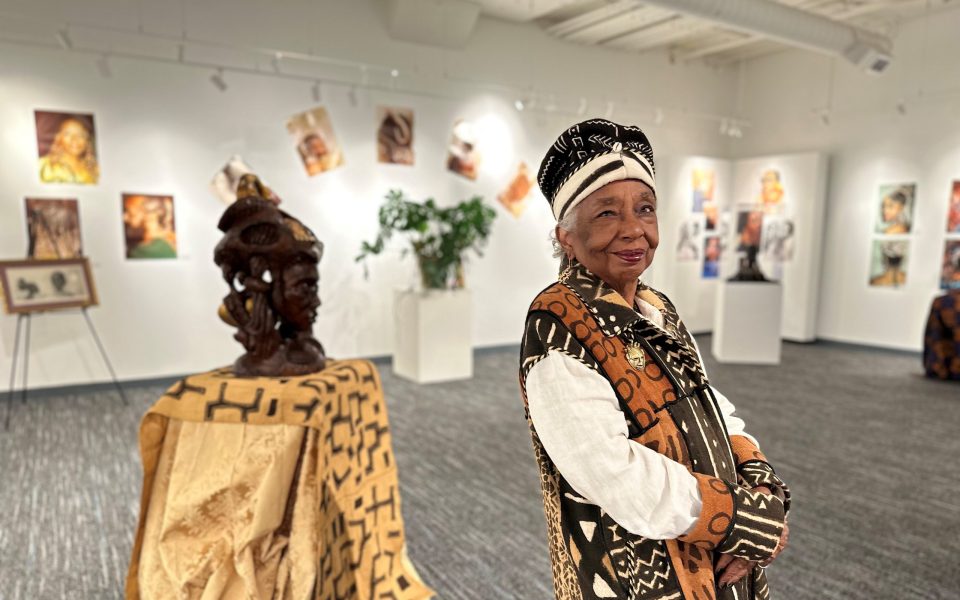Featured photo: Rosa Malikia Johnson has been braiding hair for more than five decades (photo by Katie Hall)
If Stevie Wonder’s hair appointment was at 5 p.m., Rosa “Malikia” Johnson wouldn’t see him until midnight.
“He was always late; bless his heart,” Johnson says while fondly remembering Wonder’s quirky habits.
He also kept a keyboard in tow, constantly working on new music while Johnson braided his hair.
Her work is seen on the cover of Wonder’s 1980 album Hotter Than July, where he dons collarbone-length braids, the ends of which are decorated with beads of various shapes in many tones of red and yellow, reminiscent of the summer heat.
“You’ve seen her work, now, know her name,” is what Matema Hadi says about her mother, known as the “Queen Mother of Braids.”
Johnson, in partnership with Hadi’s event company Forever Nubian Productions, is hosting Straw Into Gold, an exhibition currently on display at Milton Rhodes Center for the Arts in Winston-Salem featuring more than 100 photographs, artifacts and three-dimensional objects created or collected throughout Johnson’s career from the 1970s to the early 2000s. Despite the grand braiding designs seen in the photographs, Johnson couldn’t do those elaborate twists at first.

“I didn’t grow up doing it [braids],” she says. “My family did my hair until I was about 14.”
Fast forward to the 1970s, when Johnson and her four children were living in Hollywood with singer Abbey Lincoln. Superstars, including comedian Redd Foxx, were in and out, with Johnson braiding their hair to pass the time when they visited. She’d travel to Oakland to show her friends her improving work. Eventually her braids got smaller, her styles became neater and her parts became crisper. With some encouragement from Lincoln, Johnson turned her passion into a paycheck.
“Braiding became a way to raise my children,” Johnson says.
Her star-studded social circle included actress Beah Richards, who convinced her to teach braiding classes for even more income. In the exhibit, hand-drawn diagrams from her time teaching classes at Los Angeles Inner City Cultural Center are on display, with Johnson showing her students how to plan a design on paper before physically practicing it. She favored balance and form in hairstyles.
“If they could draw a design, they could part it. If they could part it, they could braid it,” Johnson says.

Johnson perfected her craft, taking inspiration from African art to create hairstyles. She realized the checkerboard scores and other patterns seen in the hair of ancient African art paralleled braids and tried to duplicate the designs she saw. Miriam Makeba, a South African singer, showed her how to elevate her designs by adding extensions made of human hair, fibers and other materials. Johnson is recognized for her detailed beadwork seen on Cicely Tyson and Nina Simone, but there was one singer she really yearned to style.
“If anybody knows Stevie Wonder, tell him Malikia will braid his hair for free,” she told anyone who would listen.
Word spread to Milton Hardaway, Wonder’s older brother, who gave Johnson a call. Wonder was seeking a braider whose work would last through traveling, sweating on stage and other factors important to him. After an initial consultation, Wonder returned the following Saturday for an appointment.
According to Johnson, Wonder would spend close to $400 on the beads for his hair alone.
“We used the most precious beads for Stevie, of course,” Johnson blushes.

Delighted with her work, Wonder invited Johnson to join his travel crew, attending the 1983 Grammy Awards, Wonder’s 1984 European tour and other events. These passes are also seen in the exhibit. She traveled to his home in New Jersey where she met his daughter Aisha Morris, the inspiration for his single, “Isn’t She Lovely,” and braided her hair, too.
According to Hadi, a standout piece by Johnson is “Skyed Boat to Freedom,” which juxtaposes parts of African and Black-American culture. The base of the piece is the Golden Stool, used by Ashanti royalty and is a symbol of power. On top of the stool rests a boat, representative of the vehicles used during the Transatlantic slave trade. In the center sits the Adrinkra symbol Gye Nyame, meaning “omnipotence and supremacy of God.” From each end of the boat dangles strings of gorgeous crystal beads and jewels like raw jade and amber, serving as the spirits of those who refused enslavement by jumping or died during transport. On top of the boat are four glasses, the outside of which are decorated with antebellum-era blackface images; however, from each cup extends a fancily-dressed Black Barbie doll with an elaborate, twisted hairstyle decorated with colorful thread. The dolls represent symbols of perseverance, literally standing tall despite the sordid history from which they emerge.
“Those dolls represent the resilience of Black women by wearing our hair and embracing our beauty and will to survive,” Hadi says.

Hadi recollects growing up and spending time with her mother at the hair salons she owned, one being the Pickaninny Cornrowing Company in LA. Johnson purposely chose the name to combat negative stereotypes associated with the word pickaninny, a racial slur for Black children. Despite how they arrived, each customer left the shop beaded, braided and beautiful. Laughter filled the air as customers and stylists shared stories. Local artisans brought fabric, jewelry and food to sell. Pine-scented incense smoke wafted through the air as blues and soul music played on the radio.
“It was definitely a whole vibe,” Hadi says.
Johnson relocated to Winston-Salem nearly 20 years ago at the request of her aunt, poet Maya Angelou. Hadi joined her a decade later. Together, the two collaborate on hosting what Hadi calls “Afro-chic events that highlight Black people from the African diaspora in film, music and art,” explaining how African history has and continues to inspire Black-American culture. Johnson takes pride in her collection, and she’s especially grateful to be able to tell her own story and share it with the public.
“I’m happy I’m able to share photographs, diagrams and slides of the work I’ve done from the 70’s until now,” Johnson says.
View Straw into Gold: A Photographic Journey featuring Rosa “Malikia” Johnson at Milton Rhodes Center for the Arts until Mar. 11. An exhibition opening reception will take place on Feb. 3 at 5 p.m. Find more information at intothearts.org/strawintogold.
Join the First Amendment Society, a membership that goes directly to funding TCB‘s newsroom.
We believe that reporting can save the world.
The TCB First Amendment Society recognizes the vital role of a free, unfettered press with a bundling of local experiences designed to build community, and unique engagements with our newsroom that will help you understand, and shape, local journalism’s critical role in uplifting the people in our cities.
All revenue goes directly into the newsroom as reporters’ salaries and freelance commissions.


Leave a Reply